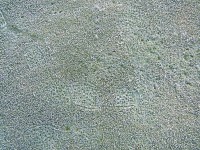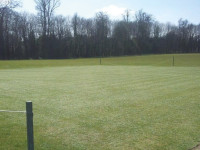
At home, it looks like we could be in for quite a harsh winter. As always advised, keep off frost affected turf; walking on it will cause the brittle leaves to break, thereby causing severe damage and, in some cases, death of the plant. If in doubt, stay off.
Key Tasks for December

Square: - Inspect your ground regularly for disease, worm activity, and spray as required. Dragbrush your square to remove any surface moisture to discourage any disease, and sarrel roll to keep the surface open. Mow the outfield and square as required.
Spraying: - The difficulties with spraying chemicals at this time of the year is getting an accurate forecast to know when there is a dry enough window of opportunity, the last thing you need is to spray a chemical for it to be rendered ineffective by weather. These products are expensive enough to buy in the first place. Worm treatments can be carried out if needed, but please remember to ask yourself why worms are present. pH levels are usually the main factor but, organic matter and your cultural practices on the square need to be assessed. Carbendazim is now the only active ingredient available for controlling worms.
Mowing; The use of a rotary for mowing the square will be more beneficial as it will reduce the effect of surface compaction. Maintaining a consistent height of cut on both square and outfield is very important, as this helps to encourage sward density, the square should be maintained between 12-20mm with the outfield between 25-35mm. Remember the outfield too has a major effect on a game if unattended.
Outfields: - Too many clubs tend to neglect their outfields, it is important to undertake some work on these areas as they play an important part of the game. They need to be firm, flat and free from weeds. The outfield should be treated through the winter the same as any other natural grass surface, Fertilising and mowing should not be neglected. Some cricket outfields are often maintained as winter sports pitches and the amount of work carried out may be determined by whether it is used for other sports (football/rugby).
Depending on ground conditions, some clubs may be able to complete drainage or reconstruction works during the winter months. Existing drainage systems can be overhauled and cleaned out, and additional drainage systems may be added.
Aeration treatments are of a fundamental importance. If not done so already, aerate your square and outfield. If your outfield is used for winter sport, link the work into your management programme. All soils are prone to compaction, but heavy clay soils which are inherently poor draining are particularly susceptible. To counteract existing compaction, aeration work should be seen as an ongoing process which must be carried out with modern, efficient equipment to achieve maximum benefits.
Deep penetration should be the objective to allow air in, facilitate water infiltration to lower levels and encourage deeper grass rooting. Without good gaseous exchange and movement of surplus water, excessively soft thatch riddled playing surfaces will be dominated by shallow rooted annual meadow grasses. For alleviating deep seated compaction, Verti-draining is invaluable and has become an integral part of a maintenance programme at many clubs. To maximize the benefits of Verti–draining, treatments must be carried out before ground conditions get too wet.
Verti-draining with solid tines are best suited for this work, as this will reduce deeper compacted layers and reduce the risk of panning; Slit tining is a preferred option as this opens up the surface and is much quicker. Hollow tine aeration has a key role in combating soil compaction within the top 75-100mm of the profile too, followed by a sandy top dressing mix will assist a more freely draining playing surface. In the main, you should be looking to aerate throughout the winter period on a monthly basis, weather and soil conditions permitting.
Nutrient Levels: Keeping a balance of N P K nutrients within the soil profile is essential for healthy plant growth. Once you have this information, you will be in a better position to plan next season's feeding and maintenance programmes.
Fertilising: When air and soil temperatures drop, this reduces the respiration rate of the grass plant. The grass plant is now entering its dormant stage. Applying fertilisers during December and through the winter months is not a viable option. The plant cannot and will not be able to make good use of the nutrients, and any growth produced by the plant may be susceptible to disease attack.




December heralds the beginning of the meteorological winter and, consequently, inputs are at a minimum as cold soil temperatures slow metabolic activity of both microorganisms and plants to a crawl. As always, keeping an eye on weather forecasts is fundamental in being able to make decisions regarding inputs.
If cool humid conditions prevail, there may still be a risk of fungal diseases. Accordingly, timings of fungicide and plant stimulating nutrition, such as calcium, phosphite and silicon, can be made in suitable weather windows for spraying. It is worth noting that calcium and silicon, in particular, will aid the plant in resisting abiotic (environmental stress) in the form of frost, snow and harsh desiccating winds. Maximising the baseline level of soil and plant health going into harsh environmental conditions will greatly aid the quality of surfaces for longer.
Cold conditions require a move away from systemic fungicides, with iprodione generally being the active of choice for many.
Be aware that withdrawal of iprodione is pending and you will not have this tool in the locker the same time next year.
Where disease outbreaks have occurred, target dormant spores in the thatch with an application of fludioxonil; this should be done in-between disease outbreaks but not during. The reason for this is due to the fact that, during outbreaks, spores are not spores but rather active disease now going through its life cycle with the aim of creating more spores as its end goal. This tactic of applying fludioxonil will reduce the background population and minimise the severity of further outbreaks once weather conditions for disease proliferation occur.
Chlorothalonil is another contact active ingredient which can be employed at this time of year. Hopefully, a well thought out disease management plan is being employed where timings of non-pesticidal plant nutrition is factored around appropriate fungicide treatments, which pay attention to the correct rotation of the relevant fungicide groups of the active ingredients being chosen.
Avoiding back to back applications of the same groups is a core responsibility for adhering to best practice and managing pathogen resistance. The FRAC website has more details and Syngenta provide some good practical information of how their products can best fit into this important consideration.
Dew may still be heavy at times, contributing to the problem of leaf canopy humidity which, in turn, leads to the spread of fungal pathogens. Removal of dews is a core fundamental cultural control for turf managers in all situations and should remain so. However, dews can be reduced by the application of a dew dispersal agent which will act to stop them forming in the first instance. This adds another element into an integrated approach to disease management, particularly on any persistently damp days when dews re-form post brushing. The key here is to minimise the period of continual leaf blade wetness as much as possible.
An important point of note when using dew dispersants; for best efficacy and longevity, they MUST be applied to a dry leaf.
Another tactic in the integrated locker is penetrant wetting agents. We are all familiar with using wetting agents to help prevent against dry patch in the summer, where they either facilitate the ingress of rain and irrigation into the profile or spread and hold it once it is in there. The flip side of this is using penetrant wetting agents in the autumn and winter to facilitate the efficient passage of water away from the surface and through the profile towards drainage systems. This has two advantages; firstly, by moving water faster through heavier soils or thatchy surfaces prone to waterlogging, you help to maintain an appropriate air/water ratio in the soil. This helps to stop the microorganisms you have spent all summer promoting from drowning. The other factor is that beneficial mycorrhizae and saprotrophic (composting) fungi really don’t like to be waterlogged. If you keep getting thatch build up on waterlogged areas which you know are not overfed, it is probably because the soil system cycle designed to degrade the organic matter is breaking down each and every autumn and winter once it becomes waterlogged.
A further benefit from using a penetrant wetting agent is that the better water penetration from the surface also helps to reduce canopy humidity, and thus the risk of fungal disease.
Aeration is a key activity to maintain throughout the winter, in whatever way possible. Be careful not to drive over waterlogged or wet ground, or also disturb surfaces with holes which will not heal in good time. Little and often with star, slit and sarrel tines, whenever possible, is probably best, especially if you have already been able to aerate deeper in the autumn. Again, the aim is to maintain a health air/water ratio for the benefit of soil life and plants.
Please note: More information on diseases can be found here: https://www.pitchcare.com/useful/diseases.php
James Grundy – Senior Technical Manager
Inspecting and cleaning of machinery - December is an ideal time to send any machinery away for repairs or servicing. Keep a good supply of materials such as loam and seed at hand for repairs and maintenance.
Check H.O.C Ensure cutting cylinders are sharp & set to winter mowing.
Keep machinery in good order, clean after use and top up any oil/fuel levels.

There are two courses - Spring & Summer Maintenance and Autumn & Winter Renovations.
Our next Spring & Summer courses will be held:
READING CC - Tuesday 6 March 2018
MARCH CC, Cambridgeshire - Thursday 22 March 2018
Up to date information can be found on our Grounds Training website.
Delegates attending the courses and using the accompanying manuals will be able to develop their own skills, working knowledge and expertise, by understanding the method of instruction and the maintenance principles they set out. Included in the Course Manuals are working diaries showing the range of tasks needed to be accomplished each month.
The Course Manual is available for purchase separately.
If you have some time to yourself over the winter months, you could also enjoy this training ONLINE. The Lantra accredited course in Cricket Pitch Maintenance is a series of training videos, each followed by multi-choice questions and answers. In addition to the videos, the accompanying comprehensive Course Manual is also included. There is a choice of courses - Spring & Summer and Autumn & Winter - more information.
We are also able to arrange courses to be delivered on site to groups of 6 – 10 people. Email Chris Johnson for information.
Latest discussion points on the Pitchcare Forum:


